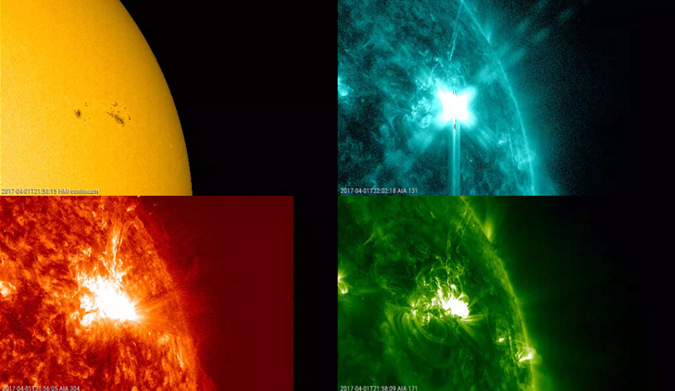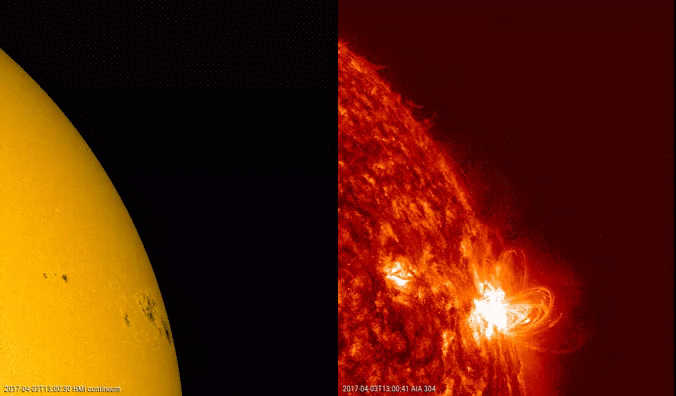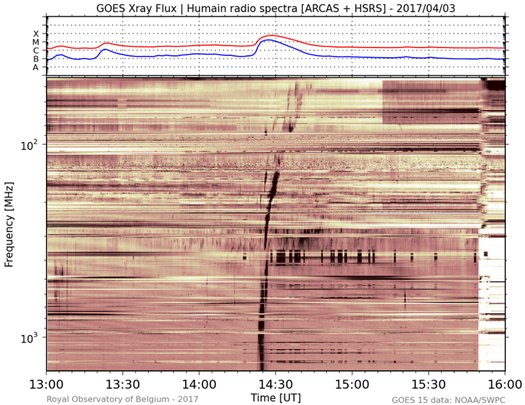It's no April Fool's day joke: On 1 April, the Sun produced its first M-class flare since 29 November 2016. The source region was NOAA 2644, which had also broken the long solar flare silence the week before (see this news item). NOAA 2644 was actually a very quiet region, until early on 1 April when suddenly new magnetic flux emerged north of the main leading spot. Interacting with embedded opposite magnetic polarity spots, it didn't take long before the active region started to produce intense flares. A compilation of SDO movies created with JHelioviewer software can be found here.

The first movie (above) compares white light imagery with magnetic development. One can easily see the emergence of the magnetic flux (negative (inward); blue) and subsequent development of the large and complex sunspots. In fact, around 31 March (beginning of the movie), the total area of the sunspots was similar to the total surface area of the Earth. However, just a few days later, it had tripled in size! The next clip shows the evolution on 1 and 2 April in white light (about 6000 degrees) and 3 passbands in extreme ultraviolet (EUV) at temperatures of resp. 80.000 degrees (AIA304; red), 700.000 degrees (AIA171; green) and several million degrees (AIA131; blue). There's an obvious increase in number and intensity of the flares as the sunspot group grows in size and magnetic complexity. The still image below shows the M4.4 flare just after its peak x-ray flux on 1 April. It was the first of the series of 7 M-class flares produced by NOAA 2644.

The next two movies show some of the strongest flares produced by NOAA 2644. The first movie compares white light and EUV (AIA131) imagery. It concerns the M5.7 flare on 2 April peaking at 20:33UT, preceded by a long duration M2 flare just 2 hours before. The latter shows a very nice cusp ("candle flame"), indicative of magnetic reconnection. The M5.7 event was a more violent eruption, taking place in the northernly portion of the region. The second movie also compares white light and EUV (AIA304) imagery. It concerns the M5.8 flare that peaked on 3 April at 14:29UT. The images show a massive ejection of plasma, with some of the material channeling back along the magnetic field lines to the solar surface afterwards.


Radio telescopes in Humain were able to capture the radio burst associated with the latter flare (M5.8). The picture underneath is a radiospectrum that combines observations from ARCAS (45 – 275 MHz in this plot) and HSRS (275 – 1495 MHz), both radio receivers at the Humain Solar Radio Observatory. The frequency scale is plotted on a logarithmic scale (vertical axis) and decreasing upward. More info on these receivers in this STCE Newsitem and realtime imagery at their website. A clear radio disturbance can be seen around the time of the x-ray flare (see annotated version), at about 14:25UT. This is a type II burst, and indicative of a shock propagating through the corona, the Sun's outer atmosphere. The associated coronal mass ejection was not directed to Earth. It was the first Type II radio burst observed by ARCAS (Augmented Resolution Callisto Spectrometer) since it became operational late October 2016.






